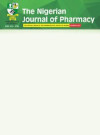Effects Of Carissa Edulis Leaf Extract On Hematological Parameters Of Ccl4 Induced Albino Rat
Keywords:
Carissa edulis, Erythropoietin,, Thrombopoietin, Hematological Parameters, CCIAbstract
Background: The aim of this study was to investigate the effffect of Carissa edulisleaves extract on some hematological parameters of rats treated with carbon tetrachloride.
Method: Thirty male albino rats were randomly allotted to six groups of fifive rats per group. The animals were treated with (250, 500 and 1000mg/kg) of Carissa edulis leaf extract. The extract was given daily by gavage to the animals for 28 consecutive days. The 50% V/V CCl4 Carbon tetrachloride and olive oil was gavaged through the gastric tube twice a week for 4 weeks to cover the duration of treatment (28days). The animals of the normal control group were given 5ml/kg of distilled water while the animal of the CCl4 treated group were administered with CCl4 only twice a week for 4 weeks. Hematological parameters investigated included; Red Blood Cell, White Blood Cell, Platelets, Packed Cells Volume, Neutrophils, Lymphocytes, Monocytes, Eosinophils, Basophils and Hemoglobin.
Results: Results of the study revealed that CCl4 group caused a signifificant decrease in most of the hematological parameters while the extract treated groups showed an increase in the same parameters.
Conclusion:This suggests that the plant extract may possess some erythropoietin, thrombopoietin, and a positive effffect on the immune system.
References
Kipkore W, Wanjohi B, Rono H &Kigen G (2014). A study of Medicinal Plants used by the Marakwet
Community in Kenya. Journal of Ethno biology and Ethno medicine 1(0):24.
Wang Z & Liu X. (2013).Perceived risk and organizational commitment. The moderating role of
organizational trust. An international journal2013; 4(1):229 – 240. https://doi.org/10.2224/sbp.2013.41.2.229
Edsziri H, Maha M, Mahyoab MA&Aouni M (2011). Antiviral activity of leaves extract of Marrubium
Alyson L. Journal of medicinal plant research 5(3): 360 –363.
Bahmani M, Zargaran A, Rafieian – Kopaei M & Saki K (2014). Ethno botanical study of medicinal plant used in the management of diabetes mellitus in the Urmia, Northwest Iran. Asian Pacific Journal of Tropical Medicine (1):348 –354.
Rafieian-Kopaei M, Sewell RD (2014).Aclinical trial of the effect of St. John's Worth on migraine
headaches in patients receiving sodium valproate. International Journal of Pharmacology1 (0):366 –
Merck M (2012).Hematologic reference ranges. Merck. Veterinary Manual. Retrieved from
http://www.merk manuals.com
Ovuru SS &Ekweozor IK (2004). Hematological Changes associated with crude oil ingestion in
experimental rabbits. African Journal of Biotechnology3 (1):346-348.
Jagger JE, Bateman RM, Ellsworth ML & Ellis CG (2001). Role of erythrocyte in regulating oral oxygen
delivery mediated by hemoglobin oxygenation. American Journal of Physiology and Heart Circulatory Physiology2 (80): 2833-2839.
Sprague RS & Ellsworth ML (2012). Erythrocyte derived ATP and perfusion distribution; role of
intracellular and intracellular communication Microcirculation1 (9): 430-439
Bonsu, B.K., Harper, M.B. Leukocyte counts in urine reflect the risk of concomitant sepsis in bacteriuric infants: A retrospective cohort study. BMC Pediatr 7, 24 (2007). https://doi.org/10.1186/1471-2431-7-24
Laki K (1972). Our ancient heritage in blood clothing and some of its consequences Annals. Network Academic Sciences20 (2): 297-307.
Richard AM, Matthew RP, Naïf Z & Abraham J (2008).Henry's clinical diagnosis and management by
laboratory methods; Philadelphia, PA: Elsevier/ Saunders 2008.
Lee G, Andrew I & Schafer H (2006). Goldman's Cecil medicine Philadelphia: Elsevier/Saunders.
Heinz J (2008).Coagulation disorders. Concise Manual on Hematology and Oncology 371-386
Abboud G & Kaplowitz N (2007). Drug Induced Liver Injury. National Library of Medicine National
Institutes of Health: 30(4): 227- 234.
Girish &, Pradhan SC (2008). Drug development for liver diseases: focus on picroliv, elegiac acid and
curcumin. Fundamental clinical pharmacology 22(6): 623 –632.
Bandyopadhyay U, Das D & Banerjee RK (1999). Reactive oxygen species. Oxidative damage and
pathogenesis. Curriculum science, (7):653 –666.
Yamamoto A (2000). Reversal of neuropathology and motor dysfunction in a conditional model of
Huntington's disease. Pub med US national library of medicine national institutes of health. 101 (1):57 – 66
Olagungu FI, Adesiyan IO, &Ezekiel AA (2007). Economic Viability of Cat Fish Production in Oyo
State Nigeria. Journal of human ecology; 21(2):121 – 124.
Paniagua AC and Amariles P (2017). Hepatotoxicity by Drugs, Pharmacokinetics and Adverse Effects of Drugs - Mechanisms and Risks Factors, Ntambwe Malangu, Intech Open, https://doi.org/10.5772/intechopen.72005
Dawkins MJR (1963). Glycogen Synthesis and Breakdown in fetal and Newborn Rats Liver. Journal
of the New York Academy of Sciences111 (1): 63.
Shander A, Hofmann A, Gombotz H, Theusinger OM &Spahn DR (2007). Estimating the cost of blood past present and future directions. Best Practical Research in Clinical Anesthesiology2 (1): 271-289.
Tobill JE & Brignoli R (2007). Iron (111) hydroxide in Iron deficiency Anemia review and meta-analysis. ArzneimiHelforshung 5(7): 431-438.
Drueke TB, Locatalli F, Clyne N, Eckardt KU, MacDougall IC (2006). Normalization of hemoglobin level in patient with chronic kidney disease and anemia. New Zealand journal of medicine3 (55) 2071-2084.
Tolo FM, Rukunga GM, Muli FW & Njue W (2006). Antiviral Activity of the Extracts of a Kenyan
Medicinal Plant Carissa edulis against herpes Simplex Virus. Journal of Ethno pharmacology
(4):92-99.
Trease GE& Evans WC (1989). Pharmacognosy, 13th (Ed). ELBs / Bailliere, Tindall, London 345 –34 6,

Views | PDF Downloads:
362
/ 323
/ 0
Published
How to Cite
Issue
Section
License

This work is licensed under a Creative Commons Attribution-NonCommercial 4.0 International License.


